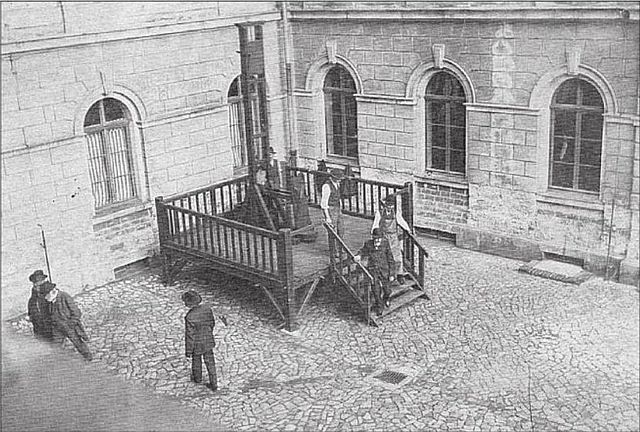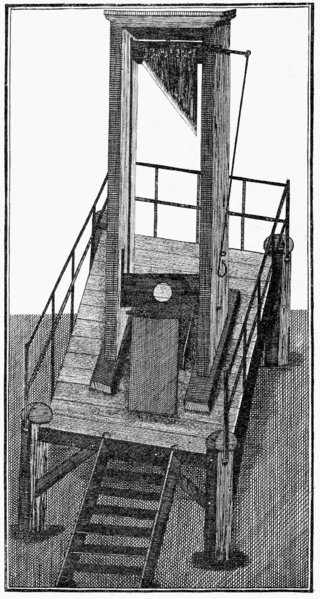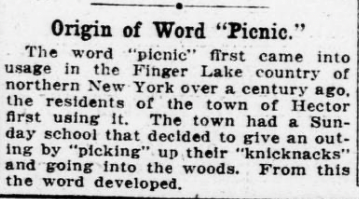
Historical accounts of France’s guillotine executions give us a fascinating insight into the lives of the people during the 19th and early 20th centuries. Crime and poverty were rampant. People sought easy ways to make a buck, and paid dearly for their crimes. Murdering family members was as horrendous as it is today, and children were often the victims of the worst crimes.
Public guillotine executions served as a warning to others, although that warning was often unheeded. It was also entertainment, as people thirsted after the gore of the beheadings and the satisfaction that criminals could be brought to justice. It was a central part of life that brought people from all over the country to witness the end of one criminal after another.

Slit A Widow’s Throat
Adolphe Gamahut, a former member of the Cistercian order, was one day approached by some young men and asked if he would help them rob a widow’s home located in southwestern Paris.
Thinking he could make a quick buck, he agreed to take part in the crime. On that same night the men broke into Madame Ballerich’s home. They grabbed hold of the widow, held her down, and in the fury of the moment Gamahut took out a knife and slit the woman’s throat.
For his crime, Gamahut was sentenced to die by guillotine.
On the day of his execution, April 24, 1885, his executioners showed no compassion. Gamahut was seized and forced to walk to the guillotine. Once there, he was thrown down onto the block and beheaded.
After his head was severed from his body, his remains were transported to the local medical school and experimented upon, as doctors tried to determine whether or not the brain could still experience pain after the head had been cut from the body. [1]
Ended By The Infamous Deibler
Dominique Harsch was sentenced to die by guillotine after his trial for the murder of a young girl. His crime was brutal, but the murderer was a typical coward when it came to his own death.
On the morning of his execution, 1897, in Nancy, France, he was woken by the prison officials and told that his petition for mercy had been denied. In reaction, Harsch fell into a near comatose state and had to be physically placed in a chair so that he could hear Mass.
After Mass, his legs continued to fail him and he had to be carried to the guillotine. There, the infamous Anatole Deibler and his assistants awaited him.
Deibler had performed over 300 beheadings during his career as executioner and was considered a master of the guillotine, although sometimes the executions could get quite bloody.
That was the case in Harsch’s execution. He was thrown onto the guillotine and seconds later his blood spurted out all over Deibler and his assistants. [2] [3]
Had To Be Carried
The Carrara trial was a huge sensation throughout France in 1898. A mushroom merchant, Xavier Angelo Carrara, and his wife, Louise, were accused of murdering a bank messenger.
It all began when Carrara had to face the fact that his mushroom business was not producing a decent income. In order to bring in some much needed money, he and his wife burned down their stables and collected the insurance money.
The couple carelessly spent all of the extra cash and soon needed more. They hatched a new plan to murder a bank messenger and take whatever money he had on him.
When Lamarre came to their door, Carrara whacked him over the head with a cartwheel wrench. Lamarre died instantly and the couple took the 20,000 francs that was in his leather bag. His body was then dragged into the kitchen and, later, transported to the mushroom farm where the body was burned.
It did not take long for the police to track Lamarre’s last steps. As they searched the Carrara’s home, they found a sizable amount of money hidden away and the wife soon confessed, claiming that it was her husband’s idea and that he had committed the murder on his own accord.
A jury found Mrs. Carrara guilty and sentenced her to life imprisonment. Her husband, however, was given the death penalty because he was the one who delivered the fatal blow.
On his death day, Carrara had to be carried to the guillotine because his legs had given way to fear. After his execution, his remains were given to the Faculty of Medicine for scientific purposes because no family member had claimed his body for burial. [4] [5]
The Clumsy Assistant
Jean Lejour had been tried and convicted for the murder of a man in his seventies back in 1900. Sentenced to face the guillotine, Lejour was placed in a cell with two other men with similar fates.
Months had passed until early one morning in 1901 the guards walked into the cell to wake Lejour from his sleep. The other two prisoners also woke up and in the confusion each of the other men thought it was his time to go. They shivered and were thankful for another day of life when Lejour was made to dress and led out of the cell.
Lejour, a mere twenty-four years of age, did not put up a fight and faced his execution with an air of lighthearted humor. He was strapped into place and the moment was over seconds later.
As was often custom, the executioner’s assistant walked over to the basket to lift out Lejour’s head, but as he did his foot slipped and the assistant fell into the large pull of blood in front of the spectators. The gruesome sight made quite an impression and the occasion was published in newspapers across the world. [6]

Wary of Being Poisoned Before His Beheading
Having been convicted for the murders of five people, Theophile Leclerc was sent to prison to await his execution. While waiting for his final day, the French authorities decided, of all things, to have the young murderer vaccinated.
Leclerc objected, stating that he would be put to death shortly and that the vaccine made no sense, but the governor insisted. Leclerc was forcefully inoculated and afterwards complained that next they would have him tattooed for his benefit and comfort.
On the day of his execution, April 9, 1903, people crowded the streets and troops had to hold back the mob of people. It seemed as though everyone wanted to see the end of this particular serial killer.
Leclerc was woken up 4:30 AM and offered a glass of brandy which he denied because he believed it contained arsenic. He was then offered a last cigarette. Again, Leclerc turned down the smoke, believing that it was somehow doctored, and he stated that he wanted to face the guillotine with a clear mind.
He was able to walk himself to the guillotine and as the blade came whooshing down, he screamed “Au revoir” about the cheers of the crowd. [7] [8]
Murdered His Mother
Georges-Henri Duchemin was 28-years-old when he chose to commit the unthinkable. He was skilled as a pork butcher, but he preferred to live off his mother’s domestic servant income. She, naturally, grew tired of her son’s laziness and finally cut him off.
Duchemin quickly became enraged by his mother’s decision and began to strangle her, but that did not finish the woman off. Angry and frustrated, he grabbed a knife and slit her throat. Before he left his mother’s home, he grabbed what little she had in her savings.
He was caught shortly thereafter, having spent all the money, and was said to have no remorse for what he had done. When asked why he had murdered his mother, he said, “I asked her to give me a 50-franc-note, which I knew she possessed. She said, ‘No, you shall have no more money from me.’ Then I went into a passion, seized my mother, who was only partly dressed, and determined to strangle her. In five minutes she fell to the floor. But she was not dead, and was groaning, so I took out my knife and cut her throat.”
It had been over a decade since Paris used the guillotine, but they made a special occasion of it for Georges-Henri Duchemin who was executed on August 5, 1909. [9] [10]
Chauffeurs de la Drome
History provides us with an endless array of unique murderers, and not the least of these were three bandits named Urbain Liottard, Octave David, and Pierre Berruyer. These three men made their money by forcing their victims to confess where they had money hidden inside their homes and they did this by submitting the victims’ feet to red hot irons.
The men were found to have killed at least ten people and crippled numerous others during their robberies. For their criminal vocation, all three men were given the death sentence.
On the morning of September 22, 1909, crowds filled the town of Valence to witness the executions. Faces pressed against the windows and people sat on the surrounding house roofs to witness the demise of the bandits.
The criminals were woken early and offered the services of a priest, cigarettes, and cognac. Starting at 6 A.M., they were each led out, one by one, thrown down onto the plank, and had their heads severed from their bodies. The execution took roughly 6 minutes from start to finish and the crowd burst into cheers when the final head landed into the basket. [11] [12]
His Second Murder
It was late at night and the village fair was taking place outside of Mortpezat, France in 1909. Jean Hebrard spotted a young, ten-year-old girl and lured her into a nearby field. As soon as he had her away from the crowds, he strangled her.
The next morning, the girl’s body was found covered with hay and wooden boards, and Jean Hebrard was arrested just as he was about to board a train to escape the village.
Hebrard had a history with murder, having had murdered his wife several years previously. He had spent a whopping four years in prison for the first murder, but the jury was not going to be so kind to him for murdering an innocent child.
He was sentenced to die by guillotine and, for the first time in seventy-five years, the guillotine was erected in Montauban.
As was custom, the murderer did not know when his death would come, so he was surprised when the guards came into to his cell and woke him from his sleep. Disoriented at first, Hebrard began to shake uncontrollably and had to be carried out to the instrument of his death.
People came from all across France to see Hebrard’s execution and the troops struggled to hold them back from the scaffold.
Hebrard tried to speak to the crowd before his final moment, but fear had also taken his voice away. He was executed on January 1, 1910. [13]
Barefoot And Bound
Henri Hamet made a desperate plea to his father back in 1911. He claimed that he was on his death bed, starving, and that his last wish was to see his father’s face one last time before going to meet his maker.
His father, a simple farmer, received the telegraph and left immediately to visit his son in a distant village of France. However, upon entering the room where his son lay, the son quickly leaped out of the bed shot his father.
Henri was, of course, arrested and found guilty of the murder. He was sentenced to die by guillotine under the circumstances set by customs and French law when a son murdered his father.
He was “executed barefoot, with his hands tied behind his back, a rope round his ankles and a black veil over his face. In this guise he has to stand facing the guillotine, while his sentence of death is read to him.”
All went as planned up to this point, but when it came time to place his head into the guillotine hole, he began to struggle. It lasted for well over a minute. The man who had no compassion for the person he had murdered was now fighting for his own, sad life.
The guillotine assistants wrestled with the man’s head and finally got it through the hole. One of the assistants nearly lost his hand in the process as Henri continued to try and pull his head out from the guillotine, but the deed was soon over. [14]
The Red Armchair Strangler
It was quite a love triangle that no doubt left those in the courtroom on the edges of their seats. Alain Bernardy de Sigoyer, referred to as the “Red Armchair Strangler,” walked up to his wife as she sat in the armchair and pulled out a length of clothes line from his pocket. He then proceeded to “playfully strangle” his wife as his mistress stood by and watched.
After the cruel deed was done, Sigoyer and his mistress carried the wife’s body outside and dug a shallow grave for her behind the wine depot.
After being discovered, Sigoyer went on trial. He swore on the lives of his children, two from his wife and one from his mistress, that he was innocent. He then claimed that his mistress shot his wife in the neck, but the medical examiner dismissed the accusation because there were no bullet wounds.
Try as he might, Sigoyer was not going to get away with strangling his wife. His mistress turned state evidence and Sigoyer was sentenced to die. He met with the Black Widow in Paris on June 11, 1947. [15]


